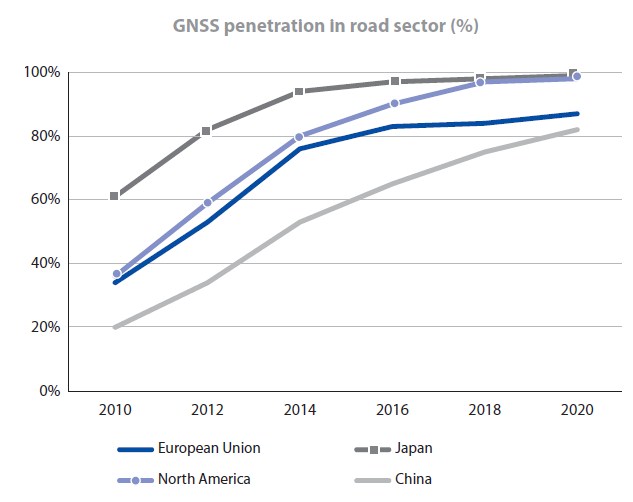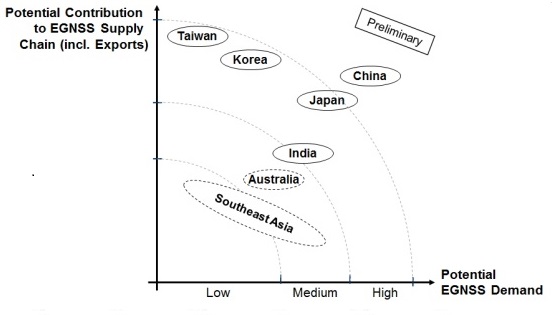Opportunities in Asia for the GNSS industry
The GNSS downstream environment in Asia
East Asia constitutes a key region for GNSS in many ways. Firstly, the Asia-Pacific rim will be a “hotspot” for satellite signal reception, and is likely to be at the forefront of multi-constellation usage. Secondly, large markets will drive economies of scale in hardware and application developments. Thirdly, this region is the manufacturing hub for electronic devices, including for the remaining European players. Fourthly, application software will increasingly be outsourced to Indian or other Far East developers.
The following figure depicts the average number of visible navigation satellites worldwide – the area covered by GNSS.asia sticks out by its high GNSS concentration, due to dedicated GNSS as well as navigation systems, whose roll-out is planned to start earlier in that area than in other regions of the world.

Asia Oceania Region is Showcase of New GNSS Era multi-Constellations (Multi-GNSS.Asia)
The first decade of the 21st century has seen China and the area covered by GNSS.asia turning more and more into the world’s workbench. The reasons for this trend are manifold, but the key factors relate to globalisation, cheap labour forces and the increasing technological capabilities in these countries. For this – and additional reasons – Japan, Korea, China, Taiwan and India have managed to establish themselves as the production and engineering centres for consumer electronics. Based on this, there is no reason to believe why GNSS downstream equipment, which represents a certain type of consumer electronic – will not follow that trend as well. Therefore one can expect that the area covered by GNSS.asia will play an – if not THE MOST – important role for the manufacturing of GNSS downstream equipment.
Similar considerations prevail for the chipsets, which are produced to serve mass markets in GNSS. Again, it is this area that is likely to be the number one region, also because users in Japan, Korea and co. are considered as “mobile phone addicts”. In this region it is a custom to use the mobile phone excessively, for all sorts of applications, be it texting, chatting, emailing, video and music streaming, etc. One does not need to be too visionary to assume that GNSS applications will see a first major roll-out in this region, especially because of the size of the market, the innovation friendliness and the fact that numerous chipset firms are producing in the region, to serve the GNSS mass markets. The figure below outlines a forecast of the GNSS penetration within mobile phones and compares this forecast for different markets.

GNSS Penetration in Mobile Phones in Different Markets (Source: GSA’s GNSS Market Report)
Both the size and growth rate of this region, as well as its GNSS affinity make it a key market to be addressed early on, especially if one wants to obtain synergies with adapted roll-outs in other corners of the world.
Due to its sheer size, the Asian market is of high importance for every product and/or service, which aims to be successful on the worldwide market. Galileo, which is to be placed as THE worldwide civilian GNSS standard is no exception. In particular, the Asian economies are of strategic interest for the European GNSS for the main following reasons:
- They represent a unique region, especially as it is (to be) served by several GNSS
- The area covered by GNSS.asia is a manufacturing centre for GNSS downstream equipment
- These economies are home to chipsets serving mass markets in GNSS
- They feature a proximity to markets with high GNSS affinity and enormous growth rates
The large relevance of European GNSS in Asian region is illustrated by the fact that a large number of contributions in the European Satellite Navigation Competition stem from Asian economies, e.g. Taiwan has actively participated for many years in the contest.
Potential for EGNSS in Asia
In order to identify the potential for EGNSS in Asia, GNSS.asia has performed extensive mapping of the downstream sectors with focus on recognising potential gaps in the local value chain for which European companies could market their solutions. The project has analysed the different features of each one of the Asian economies related to the structure of the industry e.g. SMEs vs. large conglomerates, the culture of cooperation and the openness to foreign involvement. The initial findings have been extensively discussed with European and Asian GNSS stakeholders either during the numerous seminars, workshops, thematic events and round tables organised in EU and Asia, or through direct interaction in the form of interviews and dedicated meetings. This has helped consolidate the analysis and identify the main drivers that enable industrial cooperation. It also allowed gaining solid insights on constraints that hinder the penetration of EGNSS in each of the Asian markets, including but not limited to market entry barriers, standardisation issues, cooperation scepticism or the mandated use of indigenous systems.
Thus through the process described above, the project has pursued a pragmatic approach to identify the opportunities for industrial cooperation between European and Asian companies and the necessary actions that will support positioning of EGNSS in the Asian markets. A clear conclusion from this analysis and a strong message from various stakeholders is that Asian GNSS actors are ready and willing to engage in industrial cooperation with Europe in varying degrees and in different application sectors.
The strongest enabling factors for EGNSS success are the local industry’s potential contribution to the global EGNSS supply chain (receiver, chipset production) as well as the potential demand for EGNSS applications and receivers in the respective economies. The graph below from provides an indicative positioning of the respective economies against the enabling factors for EGNSS activity in Asia.

The potential for EGNSS in Asia can be thus divided in three categories:
Potential for industrial cooperation in downstream sector
The potential of industrial cooperation in downstream applications is manifold. Indicative examples of the different commercial arrangements under which European companies could enter the local markets include: licensing (e.g. Fraunhofer IIS in Korea), in exporting successful products (e.g. STMicro, Septentrio, IFEN in several economies), in exporting services (e.g. GMV in India and Thales in Taiwan), in distribution agreements such as dealership agreements for mass market products (e.g. TomTom).
Downstream applications
The comprehensive mapping of the downstream sectors performed by GNSS.asia has allowed the understanding of the application priorities in each of the Asian economies. LBS and road transport are clearly the sectors with the largest GNSS uptake offering potential for cooperation in related applications. However in each of the Asian economies there are other sectors presenting concrete opportunities for industrial cooperation. Detailed information for each economy is presented together with recommended actions in chapter 3.
Multi-GNSS receivers
The East-Asia region and particularly Taiwan, Korea and Japan, is the manufacturing hub for the majority of chipsets and receivers produced worldwide. Therefore it is crucial that Galileo, as a civil, global GNSS system, is properly integrated in chipsets/receivers and thus used on the global scale. GNSS.asia has supported the GSA in that regard through close engagement of Mediatek (TW) and Furuno (JP).
On the Multi-GNSS level, Taiwan has progressed significantly in producing very advanced devices (e.g. GPS+GLONASS+Galileo chips) and is leading the market in sensor fusion. However, there is solid demand for Europe’s leadership in niche solutions e.g. in software integration, sensor fusion algorithms, SOC design, MEMS design. The importance of cooperation in multi-GNSS receivers is evident elsewhere too: Japanese and Korean GNSS actors have articulated their interest in high-precision, Galileo-enabled Multi-GNSS receivers; is leading the Multi-GNSS campaign with JAXA as key driver; In India several companies (e.g. ASL, Accord) are interested in joint R&D projects focusing on the development of Multi-GNSS receivers with SBAS capabilities (see also below).
Potential from the ties arising between upstream and downstream
Support in take-off of local GNSS: Even though this dimension does not fall within the scope of GNSS.asia, the project supports the monitoring of developments that present certain interest for EGNSS. The development of local GNSS can present interesting opportunities for industrial cooperation particularly in the context of SBAS. India with GAGAN and Korea with the emerging KSBAS, have actively voiced their interest in leveraging the European experience and expertise from EGNOS. European companies have supported (e.g. GMV with GAGAN ionospheric model) or can support activities related to the SBAS infrastructure, training of experts, certification schemes, algorithms, etc. One concrete case, which has been actively pursued within the project, is the support – provided through GNSS.asia expertise in Korea – to position European companies in relation to the procurement of the emerging Korean SBAS.
Joint research and education initiatives
Multi-GNSS approach: Along with the increasing importance of the Multi-GNSS approach for international cooperation, come opportunities for joint research and development of receivers, chipsets, algorithms, etc. It is within the capacity of EC and the Member States to establish the link between the political and industrial dimension, e.g. supporting EU Industry within the context of Horizon 2020.
Activating IT and engineering pools: There is an immense pool of very capable engineers and IT/Software developers in Asia and especially in India and China. Activating this pool towards the involvement in GNSS-related applications could provide additional dynamic for European companies active in EGNSS. A concrete example of cooperation along these lines and the resulting benefits is showcased in the Vulcanus programme run by EU-Japan Centre, where European GNSS engineers join Japanese companies for internships and vice versa.
GNSS education and training: The depth of GNSS knowledge and understanding is very limited in some of the Asian economies. It is very characteristic that during the Indian Industry Workshop, participants expressed their gratitude to EU funded programmes coming to India to educate them on their own SBAS system!
In Europe based upon the need to have high level engineers in GNSS in the decade to come a huge effort has been made (supported by the G-Train Project and now Genius) and is still ongoing with GNSS-focused academic training like European master in GNSS, Ph.D. training, etc.
In conjunction with the mobilisation of the capable human capital described above, several Asian actors have expressed their interest in working together with Europe in GNSS education programmes. Thus, for example, ENAC has prepared dedicated workshops in Taiwan (with the support of GNSS.asia), the University of Nottingham is branching out in India and China, and the G-NAVIS project is active in South-East Asia.
The expansion of the European Satellite Navigation Competition “Galileo Masters” could also support in that end. In this context, GNSS.asia has played an instrumental role in achieving the introduction of Galileo Masters for the first time in Japan. It must be noted though that the competitons’ sustainability needs constant grooming as evidenced by Taiwanese ITRI pulling-out in the last minute due to lack of funding.